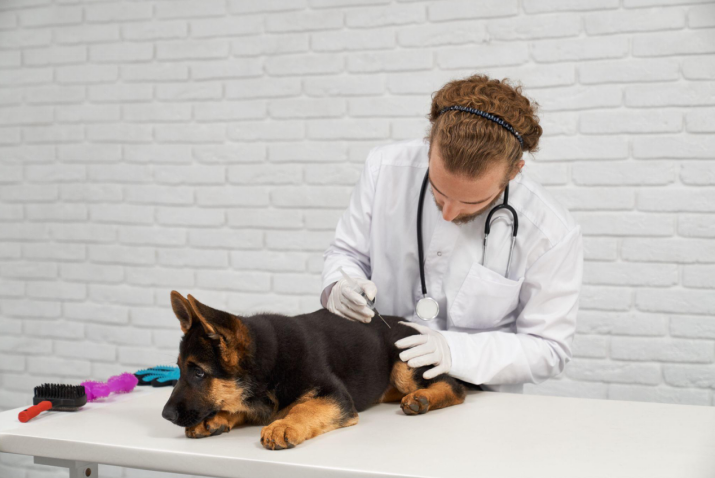Seeing your dog slow down and sleep more? Totally scary and confusing. Is it just age? Is it something serious? We will deconstruct what is lethargy in dogs, the most frequent causes, the red flag signs, what your doctor will probably examine, and practical, not-so-far-off things that you can implement.
What Does Lethargy in Dogs Imply?
Lethargy is more than laziness. It’s when the energy and passion of your dog decrease noticeably. They won't brighten up for a toy or a snack or even for a walk more than they would otherwise. A lethargic dog still likes to eat, or he won't.
Sometimes he's weak; at others, he seems simply indifferent. The complicating element? Sometimes your dog is just flat-out exhausted, a rough day of zoomies or a long hike will do that.
But lethargy can also be a red flag. The cause can go from mild (i.e., simply exhausted after a super-long day) to extreme (as in the case of toxins or heart disease). That's why observation is so important.

Signs Your Dog is Truly Lethargic
If you find yourself wondering, ‘Is this normal or not?’.
Here's how lethargy can appear:
● Lying around excessively and ignoring customary indicators
● Strolling lethargically, stumbling, or is the dog weak
● Less interested in food, play, or people
● Getting wild and cowering or getting cuddly.
● The inability to stand, walk, or even collapse.
This low energy is not something to be brushed off, even when the dog is eager enough to eat and drink, and this happens most of the time. Starting with the date and time that you initially noticed it, any other symptoms (such as vomiting, diarrhea, or cough), and the acute or slow onset.
Common Reasons Dogs Act Sluggish
There are several possibilities; these are the usual ones:
1. Tiredness, heat, or recovery
After rigorous playtime, a long workout, or a hot day, dogs can simply be exhausted. Puppies and senior dogs take longer to recover, and the heat does not help. Should they recover with rest, water, and cooldown, it’s highly probable just exercise. But monitor them closely.
2. Pain or arthritis
They conceal pain. Arthritis, tooth distress, or injury often makes them slow down but keeps them eating normally. Mobility-friendly changes such as ramps, an orthopaedic bed, and softer walks can be employed when the pain is suspected. Here is more information about arthritis, so you can know what to look out for and what to do.
3. Infection or inflammation
Viruses, bacterial illness, or Lyme disease can drain energy. These often have related fevers, shivering, or pain in a specific site. Vets typically test for infection first.
4. Endocrine or metabolic disease
Diabetes, hypothyroidism, or Addison's disease may be energy drainers. They are also able to change hunger or the urge to urinate. Tests of the blood typically disclose these.
5. Heart, lung, or blood problems
Heart disease reduces the oxygen flow, leaving the dog lethargic. Anemia (few red blood cells) also causes lethargy. These are concerning states vets rule out right away.
6. Toxins or poisoning
Some human meds, plants, foods (like xylitol), or household chemicals cause lethargy, sometimes suddenly and severely. Suspension of ingestion requires urgent treatment.
7. Cancer or chronic disease
The slight indifference that has taken several weeks or months to manifest might indicate that something is wrong with the body, such as cancer, organ disease, or progressive neurological issues. That is why it is significant to monitor trends.
Questions You Might Be Googling
My dog is acting lethargic, yet it's eating and drinking. That may occur in case of mild illness, pain in existence, but preservation of appetite, or in case of early metabolic disease development. You are not always in a hurry, but monitor the changes and provide information to your vet.
Dog suddenly lethargic: Sudden dramatic lethargy is worse. Consider toxicity, heat, hemorrhage, or acidosis. In case it is sudden and extreme, pursue an emergency.
My dog is lethargic and not himself: Behavior is a huge clue. If your usually-bouncy buddy is withdrawn, confused, or disoriented, don’t wait; get a vet check.
My dog is acting lethargic: If it’s new or lasts more than a day or two, get them checked unless there’s a clear reason (like a marathon play session). Your vet will decide what to test based on the history. Things like thyroid levels, tick panels, or blood glucose are common starting points.

When Is It An Emergency?
Head to an emergency clinic right away if your dog shows any of these:
● Collapsing, unconsciousness, or intense weakness.
● Bad perfusion/oxygen problems: Pale, blue, or very bright red gums.
● Asthma and extreme suffocation.
● Their symptoms include repeated vomiting/diarrhea and weakness or collapse.
● Poisoning, seizures, loss of orientation.
Call an emergency vet in case you are not sure; it is the only way to be on the safe side, as these are things that get out of hand.
What the Vet Will Test For
Anticipate a progressive procedure: history and physical examination initially, followed by a diagnostic procedure based on the most probable reasons.
Typical tests include:
● Bloodwork (CBC & chemistry panel) to check for anemia, infection, and organ function.
● Urine analysis to establish problems with the kidney, infection, or metabolic evidence.
● X-rays/ ultrasound when internal injury, tumor, heart/ lung problems are questioned.
● Specific tests (thyroid levels, tick disease panels, blood glucose) as indicated.
Depending on the severity of the lethargy and additional indications, a vet will decide what is most important.
At-home Care While You Wait (And What NOT To Do)
In case your dog is slightly lethargic but eating and drinking (he is not fainting, has no problems with breathing):
● Make them comfortable, cozy (or cold in case of being in contact with heat), and silent.
● Offer small amounts of water frequently, don’t force.
● Skip strenuous walks. Short, calm potty breaks only.
● Note times, appetite, bowel movements, and any vomiting. This record is gold for the vet.
What NOT to do: administer human medications (ibuprofen, acetaminophen), attempt home detox, and attempt human force-feeding in case the dog is not cooperating.
These decisions can make the situation tricky. Call your poison control or your veterinarian in case you suspect that your pet dog has ingested a poisonous substance.
Long-term Management and Lifestyle Changes
In case the lack of energy of your dog is connected with a chronic illness (arthritis, heart disease, endocrine disorders), the following convenient actions may increase the quality of life:
● Turn the house into a more accessible environment: ramps to enter/leave the cars or beds, non-slip carpets, and steps to favorite places will minimise the effort and pain. WOpet has a solid guide and top ramps roundup to help pick the right one.
● Support joints and sleep: For older dogs that nap a lot, an orthopaedic bed can actually make a real difference. Better sleep, fewer joint aches, fewer I’m wiped out days.
● Hydration matters: a pet water fountain encourages sipping and helps prevent dehydration, which can make dogs lethargic. WOpet’s water fountains actually have triple-filter fountains and user guides.
● Weight management & tailored exercise: obesity worsens lethargy and joint pain. Small, regular walks and exercise plans that are approved by veterinarians are beneficial.
● Food, drugs/supplements: Food and meds are another thing to keep an eye on. Only give what your vet prescribes. Double-check before adding supplements or ‘natural’ remedies; some of them can interact with meds or make things worse.

Products That Can Help
You asked me to guide readers toward buying fair. Here are practical things that actually make life better for a lethargic or weak dog:
1. Pet water fountains: Dogs that drink more hydrate better; fountains like the WOpet wireless models make water more appealing and are easy to clean. Great for older dogs or any pup that doesn’t sip enough.
2. Orthopaedic & cooling beds: For arthritic or senior dogs, the right bed reduces joint pain and helps promote restful sleep. WOpet’s dog gear and bed roundups talk through sizes and materials.
3. Ramps & steps: If your dog avoids jumping because it hurts, ramps take the strain off the joints and cut down on the post-activity exhaustion that follows hard landings.
4. Automatic feeders: If your dog’s appetite is hit-or-miss, a steady feeding routine helps — auto feeders keep meals on schedule, and slow-feeder bowls support digestion and lower the risk of bloat in deep-chested breeds. WOpet’s automatic dog feeder with camera can help you keep track of your dog’s daily meals.
5. Monitoring & comfort tools: A cheap notebook or app to log symptoms, plus a comfy collar/harness for gentle walks, can make follow-up vet visits way more productive.
How To Talk To Your Vet
Be a detective. Share:
● When the change started, and whether it was sudden or gradual
● Appetite and water intake (use that notebook)
● Any exposures (meds, plants, chemicals, new food or treats)
● Recent activity, travel, new pets in the house, and any meds your dog’s on
● A short video of your dog moving and resting — priceless for the vet
Vets will appreciate specifics; you'll get better, faster help.
Conclusion
Call your vet in case your dog is sleepier than usual and takes longer than one or two days to get better, or the sleepiness is accompanied by other things that cause concern. Track everything, stabilize them at home (rest, water, quiet), and consider low-effort product upgrades.
Ramps, a fountain, and a supportive bed, if the problem ties to aging or mobility. Stay chill but proactive, you’re doing the right thing by checking this out. Your dog’s energy is a big clue; listen to it.



